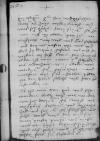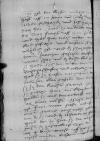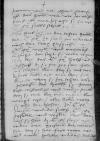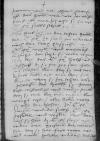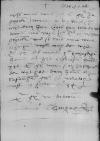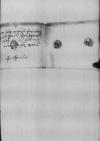Uff XI October pein ich von ⌊Augspurg(e)⌋ von ⌊wÿb⌋ und ⌊kind⌋ geschaid(en) und ⌊den vo(n) Nassow⌋ mÿt ⌊wib⌋ und ⌊kind⌋ in borgung or vorgung⌈borgungborgung or vorgung⌉ gefund(en) und mÿt im wÿder an hoff kome(n) gen ⌊Carag(os)a⌋.
Alda ÿst mier(e) Euwer G(nad)e ⌊⌋ aus ⌊Aldenhaus⌋ vo(n) 1533-10-13⌊13 October(e)1533-10-13⌋ wol word(en), E(wer) G(nad)e gesunthaÿt und wolfart mÿt frod(en) v(er)nome(n), pÿtten Got den herre(n) solichs vÿl jaur zu erstrecken etc.
So ÿst mier(e) der gut und schon merdere beltz ouch wol worden, wie ich dan E(wer) G(naden) lengst aus ⌊Augspurg(e)⌋ ⌊⌋ und anzaigt hab, und sag E(wer) G(naden) flÿssige(n) und grosse(n) danck. Wÿl den ouch fuÿr mein(e) person pruche(n) und nÿesse(n) und al zeÿt begirÿg sein, solichs und als gutzs umb E(wer) G(naden) mÿt hochst(em) flis zu beschuld(en) etc.
 BCz 1595 p. 642 So ÿst der ⌊kaÿsser⌋ und gantzer hoff uff 17 Jener vo(n) ⌊Carag(osa)⌋ nach ⌊Toledo⌋ geschaÿd(en), und ich pein mÿt dem her ⌊Couos⌋ come(n)dador maÿor de ⌊Leon⌋ straxs uff her zu kom[...] hidden by binding⌈[...][...] hidden by binding⌉, und hab hie nach ⌊mutter⌋ und kind gefragt und erfare(n), so vÿl muglich ÿst, und d(a)z schon tochterle donna ⌊Juanÿca⌋ geseche(n), das fuÿr waur schon und d(a)z recht kind ÿst. So helt sÿch die ⌊mutter⌋ fuÿr waur rechtgeschaffen und erberlich, und hab sÿ in grosser not gefund(en), das ma(n) jer alles gestolle(n) hat. Die wyl[...] hidden by binding⌈[...][...] hidden by binding⌉ ⌊sÿ⌋ in der kierche(n) gewest ÿst, so sÿ gehapt haut vo(n) klaÿder, deshalbe(n) sÿ aus der nottorfft mÿt XX ducat(en) musse(n) v(er)seche(n), dan ier ÿst fuÿr waur grosse nottorfft vor auge(n) gewest, auch nÿchs pliben, dan d(a)z sÿ und d(a)z ⌊tochterle⌋ an geho[...] hidden by binding⌈[...][...] hidden by binding⌉ hond. Dar zu hat sÿ die magtlau[...] hidden by binding⌈[...][...] hidden by binding⌉ fache(n) in gefencknost lege(n), darzu an 4 duc(aten) uncost uff gange(n) und hidden by binding⌈[d]d hidden by binding⌉ nÿchs wÿder bechome(n), und das
BCz 1595 p. 642 So ÿst der ⌊kaÿsser⌋ und gantzer hoff uff 17 Jener vo(n) ⌊Carag(osa)⌋ nach ⌊Toledo⌋ geschaÿd(en), und ich pein mÿt dem her ⌊Couos⌋ come(n)dador maÿor de ⌊Leon⌋ straxs uff her zu kom[...] hidden by binding⌈[...][...] hidden by binding⌉, und hab hie nach ⌊mutter⌋ und kind gefragt und erfare(n), so vÿl muglich ÿst, und d(a)z schon tochterle donna ⌊Juanÿca⌋ geseche(n), das fuÿr waur schon und d(a)z recht kind ÿst. So helt sÿch die ⌊mutter⌋ fuÿr waur rechtgeschaffen und erberlich, und hab sÿ in grosser not gefund(en), das ma(n) jer alles gestolle(n) hat. Die wyl[...] hidden by binding⌈[...][...] hidden by binding⌉ ⌊sÿ⌋ in der kierche(n) gewest ÿst, so sÿ gehapt haut vo(n) klaÿder, deshalbe(n) sÿ aus der nottorfft mÿt XX ducat(en) musse(n) v(er)seche(n), dan ier ÿst fuÿr waur grosse nottorfft vor auge(n) gewest, auch nÿchs pliben, dan d(a)z sÿ und d(a)z ⌊tochterle⌋ an geho[...] hidden by binding⌈[...][...] hidden by binding⌉ hond. Dar zu hat sÿ die magtlau[...] hidden by binding⌈[...][...] hidden by binding⌉ fache(n) in gefencknost lege(n), darzu an 4 duc(aten) uncost uff gange(n) und hidden by binding⌈[d]d hidden by binding⌉ nÿchs wÿder bechome(n), und das  BCz 1595 p. 643 janmer und not v(or)hand(en) gewest, ÿst des halbe(n) wie vor jer musse(n) fuÿrstreck(en), wie ich acht, sÿ hie mÿt E(wer) G(naden) selbs schrib etc.
BCz 1595 p. 643 janmer und not v(or)hand(en) gewest, ÿst des halbe(n) wie vor jer musse(n) fuÿrstreck(en), wie ich acht, sÿ hie mÿt E(wer) G(naden) selbs schrib etc.
So hab ich ⌊ier⌋ der ⌊tochter⌋ halbe(n), die E(wer) G(nade) ze send(en) ins ⌊Nÿderland⌋ nach der leng gesproche(n), und E(wer) G(nade) wÿl und maÿnno(n)g a(n)zaigt. Da sagt ⌊sÿ⌋, wolle es gern thun, doch das E(wer) G(nade) helff und v(er)schaff, d(a)z sy for gen sant Ÿsabel ins closter kome, dan sÿ wis wol, d(a)z ires lebe(n) nÿt mer lang sein kuÿnde, wan sÿ ier ⌊tochter⌋ mue superinscribed⌈ee superinscribed⌉s v(er)lausse(n), des halbe(n) sÿ v(er)main dest crÿstenlich und wolze sterbe(n), dan sÿ wil or wol⌈wilwil or wol⌉ kain ma(n) neme(n), kains wegs nÿt, / aber lieber(e) wolt sÿ mÿt der thochter zu E(wer) G(naden) zieche(n) und da selbst E(wer) G(nade) gefalle(n) und wÿlle(n) leb(en), dem nach sÿ hoe superinscribed⌈ee superinscribed⌉rt, d(a)z E(wer) G(nade) sonst vÿl ander mer persone(n) die narun(n)g gÿt, dan sy hat fuÿr waur not und armut gelÿtten und noch deshalb(en)  BCz 1595 p. 644 sÿ am liebst(en) bÿ E(wer) G(naden) sein(n) wolt und ier lebe(n) und narun(n)g alda habe(n). Und wie ⌊sÿ⌋ sagt, wÿl sÿ also E(wer) G(nade) antwort wart(en). Was dan E(wer) G(naden) maÿno(n)g und wÿl yst, wel ⌊ier⌋ E(wer) G(naden) ouch mier(e) ze wÿsse(n) thun. Wÿl ich im mÿt alle(n) flis nach kome(n) und thun, wie E(wer) G(nade) v(er)trun[...] hidden by binding⌈[...][...] hidden by binding⌉, des halb(en) zu mier(e) ÿst etc.
BCz 1595 p. 644 sÿ am liebst(en) bÿ E(wer) G(naden) sein(n) wolt und ier lebe(n) und narun(n)g alda habe(n). Und wie ⌊sÿ⌋ sagt, wÿl sÿ also E(wer) G(nade) antwort wart(en). Was dan E(wer) G(naden) maÿno(n)g und wÿl yst, wel ⌊ier⌋ E(wer) G(naden) ouch mier(e) ze wÿsse(n) thun. Wÿl ich im mÿt alle(n) flis nach kome(n) und thun, wie E(wer) G(nade) v(er)trun[...] hidden by binding⌈[...][...] hidden by binding⌉, des halb(en) zu mier(e) ÿst etc.
Ich hab muesse(n) ⌊wÿb⌋ und ⌊kind⌋ v(er)lausse(n) und wÿder in ⌊Spanya⌋ kome(n), und seche(n) mÿch der Welser hidden by binding⌈[r]r hidden by binding⌉ unpild und falsche rechnog zu Erwere(n) hoff ze. Got wel inne(n) ier untreuw und undanckparkayt hidden by binding⌈[t]t hidden by binding⌉ preche(n). Der ⌊Jeronem(us) Saÿller⌋ hat sÿch vast ungepuerlich und eubel gen mier(e) in der sach gehalt(en). Hab es umb in nÿt v(er)dient, sonder im wol und treulich in sÿner notgeholff(en). Er moe superinscribed⌈ee superinscribed⌉cht ouch solichs gar pald inne(n) werd(en) und angelt(en), dan er ÿst ietz hie in ⌊Spa(ni)am⌋ hoff es yst iederma(n) falsch und untreuw etc.  BCz 1595 p. 645 Nÿchs nuÿes wais ich E(wer) G(nade) ze schribe(n), jenert 2 tag raÿs ich mÿt dem her ⌊Couos⌋ gen ⌊Toledo⌋, vo(n) danne(n) aus wÿl ich E(wer) G(naden) wÿther schribe(n) und so was mÿrs were a(n)zaige(n). Wÿl mich d(a)s mÿt E(wer) G(nad)e als meine(n) g(nedig)e, guÿnstige(n) herre(n) al zÿt befolche(n) habe(n). Pÿt E(wer) G(nad)e mier(e) stetz zeschrib(en). Da mÿt Got dem herre(n) alzÿt befolche(n).
BCz 1595 p. 645 Nÿchs nuÿes wais ich E(wer) G(nade) ze schribe(n), jenert 2 tag raÿs ich mÿt dem her ⌊Couos⌋ gen ⌊Toledo⌋, vo(n) danne(n) aus wÿl ich E(wer) G(naden) wÿther schribe(n) und so was mÿrs were a(n)zaige(n). Wÿl mich d(a)s mÿt E(wer) G(nad)e als meine(n) g(nedig)e, guÿnstige(n) herre(n) al zÿt befolche(n) habe(n). Pÿt E(wer) G(nad)e mier(e) stetz zeschrib(en). Da mÿt Got dem herre(n) alzÿt befolche(n).
 BCz 1595 p. 642 So ÿst der
BCz 1595 p. 642 So ÿst der  BCz 1595 p. 643 janmer und not v(or)hand(en) gewest, ÿst des halbe(n) wie vor jer musse(n) fuÿrstreck(en), wie ich acht, sÿ hie mÿt E(wer) G(naden) selbs schrib etc.
BCz 1595 p. 643 janmer und not v(or)hand(en) gewest, ÿst des halbe(n) wie vor jer musse(n) fuÿrstreck(en), wie ich acht, sÿ hie mÿt E(wer) G(naden) selbs schrib etc.
 BCz 1595 p. 644 sÿ am liebst(en) bÿ E(wer) G(naden) sein(n) wolt und ier lebe(n) und narun(n)g alda habe(n). Und wie
BCz 1595 p. 644 sÿ am liebst(en) bÿ E(wer) G(naden) sein(n) wolt und ier lebe(n) und narun(n)g alda habe(n). Und wie  BCz 1595 p. 645 Nÿchs nuÿes wais ich E(wer) G(nade) ze schribe(n), jenert 2 tag raÿs ich mÿt dem her
BCz 1595 p. 645 Nÿchs nuÿes wais ich E(wer) G(nade) ze schribe(n), jenert 2 tag raÿs ich mÿt dem her 